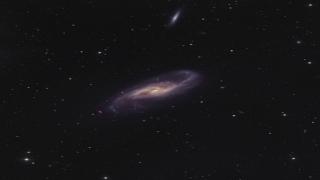Bibcode
Vega-Ferrero, Jesús; Huertas-Company, Marc; Costantin, Luca; Pérez-González, Pablo G.; Sarmiento, Regina; Kartaltepe, Jeyhan S.; Pillepich, Annalisa; Bagley, Micaela B.; Finkelstein, Steven L.; McGrath, Elizabeth J.; Knapen, Johan H.; Arrabal Haro, Pablo; Bell, Eric F.; Buitrago, Fernando; Calabrò, Antonello; Dekel, Avishai; Dickinson, Mark; Domínguez Sánchez, Helena; Elbaz, David; Ferguson, Henry C.; Giavalisco, Mauro; Holwerda, Benne W.; Kocesvski, Dale D.; Koekemoer, Anton M.; Pandya, Viraj; Papovich, Casey; Pirzkal, Nor; Primack, Joel; Yung, L. Y. Aaron
Referencia bibliográfica
The Astrophysical Journal
Fecha de publicación:
1
2024
Revista
Número de citas
45
Número de citas referidas
41
Descripción
Visual inspections of the first optical rest-frame images from JWST have indicated a surprisingly high fraction of disk galaxies at high redshifts. Here, we alternatively apply self-supervised machine learning to explore the morphological diversity at z ≥ 3. Our proposed data-driven representation scheme of galaxy morphologies, calibrated on mock images from the TNG50 simulation, is shown to be robust to noise and to correlate well with the physical properties of the simulated galaxies, including their 3D structure. We apply the method simultaneously to F200W and F356W galaxy images of a mass-complete sample (M */M ⊙ > 109) at 3 ≤ z ≤ 6 from the first JWST/NIRCam CEERS data release. We find that the simulated and observed galaxies do not exactly populate the same manifold in the representation space from contrastive learning. We also find that half the galaxies classified as disks-either convolutional neural network-based or visually-populate a similar region of the representation space as TNG50 galaxies with low stellar specific angular momentum and nonoblate structure. Although our data-driven study does not allow us to firmly conclude on the true nature of these galaxies, it suggests that the disk fraction at z ≥ 3 remains uncertain and possibly overestimated by traditional supervised classifications. Deeper imaging and spectroscopic follow-ups as well as comparisons with other simulations will help to unambiguously determine the true nature of these galaxies, and establish more robust constraints on the emergence of disks at very high redshift.
Proyectos relacionados

Las Galaxias Espirales: Evolución y Consecuencias
Nuestro grupo pequeño esta bien conocido y respetado internacionalmente por nuestro trabajo inovativo e importante en varios aspectos de la estructura y la evolución de las galaxias espirales cercanas. Usamos principalmente observaciones en varias longitudes de onda, explotando las sinergías que nos permiten responder a las cuestiones más
Johan Hendrik
Knapen Koelstra

Huellas de la Formación de las Galaxias: Poblaciones estelares, Dinámica y Morfología
Bienvenida a la página web del g rupo de investigación Traces of Galaxy Formation. Somos un grupo de investigación amplio, diverso y muy activo cuyo objetivo principal es entender la formación de galaxias en el Universo de una manera lo más completa posible. Con el estudio detellado de las poblaciones estelares como bandera, estamos constantemente
Anna
Ferré Mateu